EMERGENCY ACTION PLAN_
Emergency Action Plan updated July 24, 2020
This action can be used in your sport club or while at competitions.
The Emergency Action Plan includes three main areas of concentration:
-
Person in Charge
-
Call Person
-
Control Person
Person in Charge
Where possible, the person in charge should be an individual with specialized training in injury care or first aid.
The duties of the person in charge include all of the following:
-
Initially when coming in contact with the injured athlete, take control, and assess the situation.
-
Instruct any bystanders to leave the athlete alone.
-
Do not move the athlete; leave any equipment in place.
-
Evaluate the injury. This may include anything from an unconscious athlete to a sprained finger. Once you have assessed the severity of the injury, decide whether or not an ambulance is required.
-
If you are certain that an ambulance is not needed, then decide what action is to be taken to remove the athlete from the playing surface.
-
If an ambulance is required, then notify your call person, give a brief explanation of the injury and tell them to make the call for the ambulance.
-
Once the call has been placed, observe the athlete carefully for any change in condition and try to calm and reassure the injured player until professional help arrives.
-
STAY CALM – Keep an even tone in your voice.
-
Make note of time which injury occurred.
Call Person
If it is deemed necessary or advisable to summon emergency medical services and transportation, a call person should be pre-assigned to call for emergency services.
-
Know the location of all emergency telephones.
-
Have a list of all emergency numbers related to the city or town in which the program is taking place. (i.e. on your person, in the trainer’s kit.)
-
These numbers should be written on a wallet size card and carried at all times.
-
If possible, telephone numbers should be permanently placed by the emergency telephone.
-
Display specific directions of the best route to the arena.
-
Quarters should be carried at all times if the emergency telephone is a pay phone. If quarters are not available call the operator or 911.
-
Do not rely on numbers being posted by the telephone.
-
Do not rely on the operator to transfer the call or messages. Stay on the line until you are sure that the message has been given.
-
STAY CALM when giving information.
Information the Call Person Must Give the Dispatcher:
-
State that it is a medical emergency.
-
Give the location – clearly and calmly.
-
State what the emergency is. Is athlete conscious? Breathing normally? Bleeding? etc.
-
Give the telephone number from which you are placing the call. This is in case they have to phone back for more information. Have someone stay by the phone if possible.
-
Give the dispatcher the best route into the arena.
-
Ask for the estimated time of arrival of the ambulance to the arena.
-
Wait for them to hang up first.
-
Report back to person in charge and confirm that you have made the call and give the estimated time of arrival of ambulance, etc.
Control Person
For the Emergency Action Plan to be effective someone must be assigned for crowd control.
-
Discuss the plan with the other people involved.
-
Ensure that team-mates and spectators are not in the way of the Person in Charge.
-
Ensure that the route for the ambulance crew is clear and available.
-
If the Person in Charge feels it is a serious injury, inquire if there is highly trained medical personnel available (i.e. MD, Nurse) in the area. Inquiry may be accomplished by the loud speaker or intercom system in the area.
Person in Charge
-
Most qualified person available with training in first aid and emergency control
-
Familiarize yourself with area emergency equipment
-
Take control of an emergency situation until a medical authority arrives
-
Assess injury status of the athlete
Call Person
-
Location of emergency telephone
-
List of emergency telephone numbers
-
Directions to arena
-
Best route in and out of arena for ambulance crew
Control Person
-
Ensure proper room to work for person in charge and ambulance crew
-
Discuss emergency action plan with:
-
Facility Operator
-
Officials
-
Opponents
-
-
Ensure that the route for the ambulance crew is clear and available
-
Seek highly trained medical personnel (i.e., MD, Nurse) if requested by person in charge.
Accident Report
SOO is interested in identifying the causes of injuries and accidents so that preventative actions may be taken to reduce or eliminate potential dangers. Part of this process is the reporting of all injuries or potential injuries on the accident report form. An accident report form must be completed in its entirety for each occurrence of a physical accident or incident that may result in injury to an athlete, coach, volunteer, spectator or physical property damage. The accident report form can be found on page 19 of this section and is available from the Provincial office.
Reporting Procedure
-
The accident report form must be completed and then reviewed and signed by the staff member of SOO who will verify that the incident occurred as reported.
-
The accident report form must be completed even if no medical treatment is required.
-
If the incident involves a vehicle which is being used on official SOO business, then the Special Olympics Automobile Loss Report is also required to be completed in its entirety.
-
The form is submitted to the staff person designated at each venue and to the provincial office.
-
If the incident results in an injury and medical costs are incurred, a Special Olympics claim form will be forwarded by the insurance company directly to the injured party.
-
Claim forms will not be accepted by the insurance company without a completed accident report form



